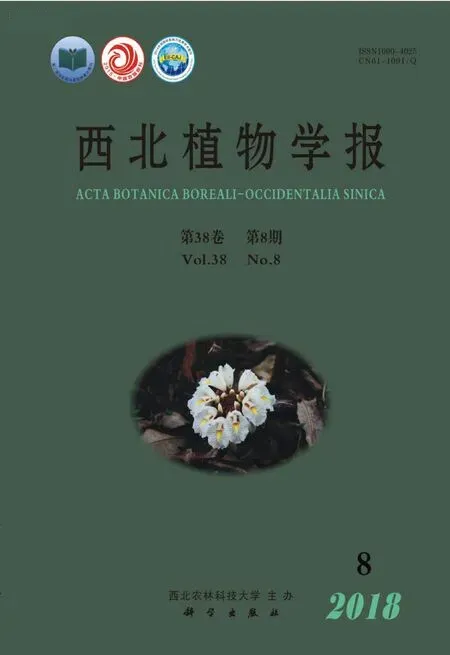湖北楠木属一新变种
——裂叶白楠
2018-02-20于鹏宇费永俊
孙 兵,肖 波,于鹏宇,潘 晓,费永俊
(长江大学 楠木种质资源评价及创新中心,湖北荆州 434025)
楠木是中国传统珍贵林木,其材质精良、树形优美,广泛用于建筑、家具、雕刻和园林绿化[1-2]。长期以来,鉴于其巨大的经济价值和广泛的用途,野生楠木资源遭受严重破坏,现已难觅天然楠木林[3]。为了摸清湖北省野生楠木资源的现状,作者承担了全国第二次野生保护植物调查湖北调查-楠木专项调查任务,并于2012~2015年期间,完成了湖北省范围内竹山[4]、竹溪、神农架[5]、兴山、秭归、长阳[6]、利川[7]、鹤峰、来凤[8]、咸丰[9]、保康及荆州周边等县市的楠木资源调查,对收集的白楠 [Phoebeneurantha(Hemsl.) Gamble] 种子进行异地播种保育,在约3万株白楠幼苗中发现了100余株叶片发生变异的幼苗,栽培4年后开花结实,其种子萌发后植株叶片变异性状稳定。通过查阅了相关文献资料[10-12],对比研究了叶片形态特征,确认系楠木属植物的一个新类群,定名为裂叶白楠 [Phoebeneurantha(Hemsl.) Gamble var.lobophyllaY.J. Fei],现予以报道。
1 裂叶白楠 新变种 (图1)
Phoebeneurantha(Hemsl.) Gamble var.lobophyllaY.J. Fei, var. nov. (Fig.1.)
The new variety has some obvious characters. The leaf width was distinctly narrowed between the middle part of leaf and 1/3 from the tip of leaf. There are strong lateral veins supporting the leaf margins. The leaves were lobed, and if not, the leaves become narrowed. The two variants are narrowed and narrow in the apex. The apex part were leptophyllous, gradually pointed and curved in the two variants. The leaf was 10-23 cm in length, 2-5 cm in width and the base part was gradually narrowed. The veins fall deeper compared with thePhoebeneurantha.The angle between the lateral veins and the main veins increases gradually, and remains unchanged after about 80 degrees after the leaf blade becomes lobed and leptophyllous. At the same time, the lateral veins become more dense, the closer to the tip of the blade, the denser the lateral veins are, and the pinnate distribution. The number of unilateral veins varied from 8-12 to 25-40. The species are now stored in the Agricultural Science and Technology Industrial Park of Yangtze University, Jingzhou National Hi-tech Zone, Hubei.The seeds were collected from the subtropical evergreen deciduous broad-leaved mixed forest in the territory of the Tujia and Miao Autonomous Prefecture of Enshi, Hubei Province(E 108°23′12″-110°38′08″,N 29°07′10″-31°24′13″). Deciduous trees are dominant in broad-leaved trees. They are oftenChoerospondiasaxillaris,Camelliaoleifera,Platycaryastrobilacea,Castaneamollissima,Phyllostachysheterocycla,Iristectorum,Pileanotataand other plants.
本变种(裂叶白楠)与白楠(Phoebeneurantha)的主要区别在于:叶片中部到距叶尖约1/3叶长处叶片宽度陡然变窄,若有强健侧脉支持则叶片发生裂刻,若无,叶片变狭长,且两种变异均存在叶片先端变狭长,渐尖,呈弯镰状,叶长10-23 cm,中部叶宽2-5 cm,基部渐狭。相比于白楠,叶脉下陷更深。主叶脉在叶片开裂变狭后,侧脉与主脉的夹角逐渐变大,大约80°左右后保持不变,同时侧脉变得更加细密,越靠近叶尖侧脉分布越密集,且呈羽状分布。单侧侧脉数较白楠的8-12条变为25-40条不等。经过对白楠叶缘和裂叶白楠缺刻处叶缘进行电镜扫描后发现,白楠叶缘下表面角质化,表面较光滑,无毛;而裂叶白楠缺刻处叶缘下表面无角质化,可明显看出细胞排列结构,且具毛。目标物种现保存于湖北省荆州国家高新区长江大学农业科技产业园内,种子采集于湖北省恩施土家族苗族自治州(E108°23′12″-110°38′08″,N29°07′10″-31°24′13″)境内亚热带常绿落叶阔叶混交林中,阔叶树种以落叶为主,林内常有南酸枣(Choerospondiasaxillaris)、油茶(Camelliaoleifera)、化香(Platycaryastrobilacea)、栗树(Castaneamollissima)、楠竹(Phyllostachysheterocycla)、鸢尾(Iristectorum)和冷水花(Pileanotata)等植物。
China,Hubei Jingzhou(湖北荆州):Agricultural Science and Technology Industrial Park of Yangtze University(长江大学农业科技产业园),alt.34 m,2016-8-3,Y.J.Fei,B.Sun,B.Xiao,P.Y.Yu,X.Pan(费永俊,孙兵,肖波,于鹏宇,潘晓)Y.J.Fei002(HIB)(Holotype,HIB),见图1。
2 讨 论
世界楠属植物共约有94种,中国分布的约有34种[13],均是中国珍稀濒危植物,素以材质优良、形态优美而闻名于世[12]。楠属植物叶片常为披针形、卵圆形或椭圆形,叶片互生,革质,分类的主要参照是叶片形态、果实形态、叶脉下陷情况以及花被、花序及叶片有无被毛等特点[12]。根据《中国植物志》[13]中有关白楠的记载,目前发现白楠有2个变种:兴义白楠 [Phoebeneurantha(Hemsl.) Gamble var.cavalerieiLiou]和短叶白楠 [Phoebeneurantha(Hemsl.) Gamble var.brevifoliaH.W.Li]。其中,兴义白楠的典型特征为:叶片狭小,长4.5-7.5 cm,宽1-2 cm,中脉在上面凸起。而短叶白楠的特征为:叶片倒卵形或倒卵状披针形,长3-11 cm,先端钝。这2个白楠变种的叶片长度均小于白楠,且无裂刻出现。本文报道的裂叶白楠与白楠存在明显的区别:中部到距叶尖约1/3叶长处陡然开裂分叉,或者无明显缺刻但叶片变狭长,两种变异均存在叶片先端变狭长,呈弯镰状;叶脉下陷程度更高,在叶片尖端侧脉数较多较细,与主脉夹角变大,呈羽状排列;裂刻处叶缘无革质化且具细毛。且这些差异性状能够在子代间稳定遗传。同时,本文报道的裂叶白楠,叶片特征与兴义白楠和短叶白楠也同样存在明显差异。给予上述理由,将其定为白楠的一个新变种——裂叶白楠。
